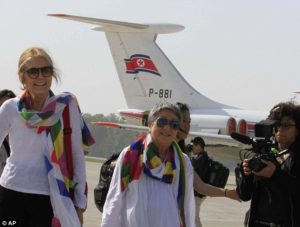Special to WorldTribune.com
 By Donald Kirk, EastAsiaIntel.com
By Donald Kirk, EastAsiaIntel.com
North Korea, that is the people who run the place, likes nothing better than endorsements from foreign visitors.
The list of foreigners paying obeisance to the Kim regime, Kim Jong-Un and his father and grandfather before him, is quite long.
The operator of a website in Los Angeles that’s known for its anti-U.S., pro-NK line has visited Pyongyang more than 60 times. He’s never been known to say a bad word about the North Korean regime or a good word about the United States, where he’s lived for decades.
A history professor from the University of Georgia has also been there more than 60 times. He specializes in rationalizations and justifications for whatever the regime does.

Two winners of the Nobel Peace Prize emerged spewing nothing but praise after visiting North Korea as part of the Women Walk for Peace last year. Neither they nor others on the trek, including the famed feminist Gloria Steinem, had an unkind word to say about the North.
A former member of the European Parliament from Britain is a regular visitor, one of a cast of ex-diplomats, officials, professors and other notables whom Pyongyang strategists count on to advance the case for a “peace treaty” that would legitimize the North’s nuclear program while speeding withdrawal of U.S. troops from the South.
Tour operators in Yanji, the major center of Chinese-Koreans near the Tumen River border, regularly take visitors to the Rason special zone, south of the river, and on to Pyongyang. They say they know nothing about defectors hiding out around Yanji. Why offend the North Koreans when they’re busy making money by selling the North as an exotic tourist destination?
I never heard of anyone seeing anything the North Koreans wanted to hide. No one has been near a North Korean prison, much less seen a trace of the gulag system in which tens of thousands are held until they die of disease, overwork or execution. Visitors see nothing of starving people dying on the streets or hospitals with no medicine, no anesthesia.
Anyone who’s been to North Korea knows how tightly all visitors are controlled. You don’t wander anywhere outside the presence of your minder.
My memory of the skills with which North Koreans shield visitors goes back to my first trips in 1992 and 1995 when I visited the country during the famine that killed between 1 and 2 million people, many by starvation, just as many by disease.
The first time I was there, in 1992, the whole point was to show journalists based in Tokyo and think-tankers from Seoul the wonders of the new economic zone at Rajin and Sonbong. North Korea was in the early stages of famine, but all we heard was the potential of the zone as a gateway to the region.
On the way up by train, at a stopover in Chongjin, we saw rusted railroad tracks and, across the harbor, steel mills built by the Japanese but long since fallen into disuse. We heard nothing of the shortages that were already devastating the city. Minders stopped us from walking outside the industrial area for a look at nearby streets.
Three years later, at the height of the famine, I was back in North Korea with a group of Korean-Canadians and Korean-Americans. We had gotten visas to witness a “sports and culture festival for peace,” but the Koreans all had signed on for the 12-day trip in hopes of seeing long lost relatives.
The Japanese wrestler Antonio Inoki had persuaded the North Koreans that pro wrestling would be just the thing to display North Korea as a global cultural force. We watched pro wrestlers from a number of countries battling each other in May Day Stadium. Muhammad Ali, diagnosed with Parkinson’s disease, was visible as a celebrity guest along with Ric Flair, a pro-wrestling celebrity.
Visitors from abroad were crowded onto the playing field as wrestlers in glittering attire tossed one another across the ring. Elderly women in our group shrieked in horror as scantily clad females shoved and bashed one another. Nobody knew the whole show was pure entertainment, not a real contest.
For the next week or so I traveled with the same group down an empty four-lane highway to the truce village of Panmunjom, east to the port city of Wonsan and south to Mount Kumkang. Everywhere we stopped for monuments and briefings. We saw no signs of famine, of disease, of human rights abuses.
For all their uncanny skills in hiding visitors from realities, not all celebrities fall for their nonsense.
After wrestling Inoki in a bout that he was scripted to lose, Flair refused to read a statement heaping praise on the regime. At a dinner, according to Flair’s account, Ali said, “No wonder we hate these mother f*****s” as his hosts boasted “they could take out the U.S. and Japan.”
WorldTribune columnist Donald Kirk covering the region for decades, has visited North Korea nine times. He’s at [email protected].
